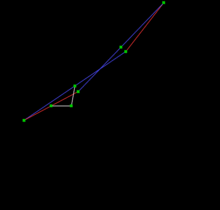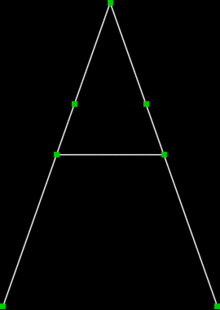Hart's inversor

Hart's inversor. Links of the same color are the same length. The relative position of the fixed point, the input, and the output along their links is the same (half, here).

Hart's A-frame. The short links are half the length of the long ones. The center link is one quarter of the way down the long links. A fixed link along the bottom of the same length as the long links is not shown.
Hart's inversor is a mechanism that provides a perfect straight line motion without sliding guides.[1]
It was invented and published by Harry Hart in 1874–5.[1][2]
It can be used to convert rotary motion to a perfect straight line by fixing a point on one short link and driving a point on another link in a circular arc.[1][3] (The fixed points and driving arm make it a 6-bar linkage.)
Hart's Inversor is based on an Antiparallelogram.
See also
References
External links
| Wikimedia Commons has media related to Hart's inversor. |
- bham.ac.uk – Hart's A-frame (draggable animation) 6-bar linkage
This article is issued from Wikipedia - version of the 11/6/2016. The text is available under the Creative Commons Attribution/Share Alike but additional terms may apply for the media files.